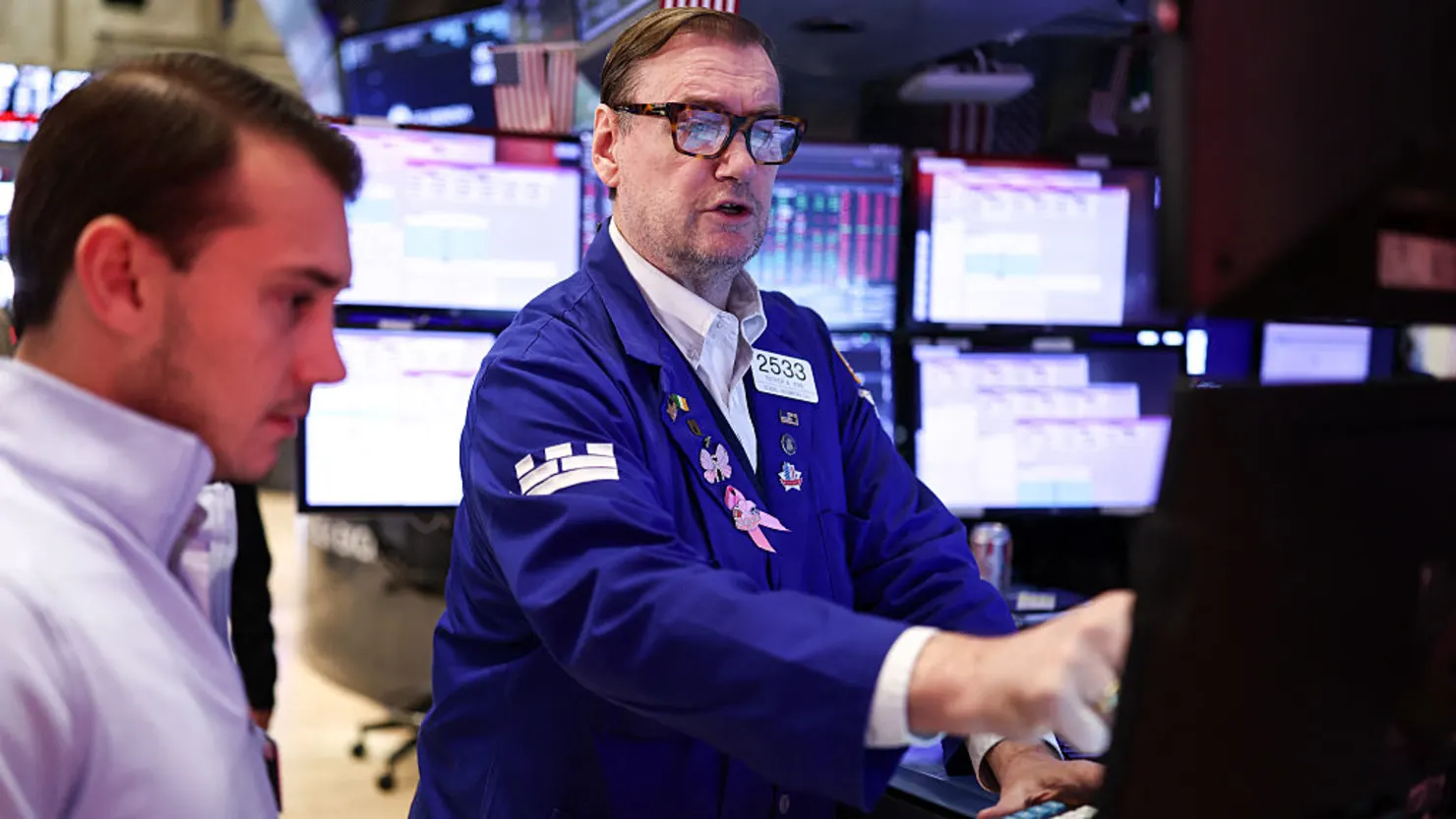The Wall Street Journal, Reuters, CBS News, Forbes, Investor’s Business Daily, Bloomberg, and CNBC contributed to this report.
It was another jumpy day on Wall Street Friday — the kind where you check your portfolio in the morning, wince, and then feel slightly better by the afternoon.
After Thursday’s sharp selloff, stocks spent most of Friday trying to claw their way back. Tech mostly managed it. The Dow? Not so much.
By late afternoon in New York, the three big indexes had staged a pretty decent intraday comeback:
- Dow Jones Industrial Average: still down roughly 0.4–0.7%, a drop of around 200–300 points after being off by almost 600–800 points earlier in the session.
- S&P 500: basically flat to modestly higher, up about 0.2–0.4% after erasing a loss of more than 1%.
- Nasdaq Composite: up around 0.4–0.7%, bouncing back from an early slide of nearly 2%.
That follows Thursday’s rout, when all three indexes logged their worst one-day losses in more than a month, with the Nasdaq down more than 2% and the Dow shedding around 800 points.
“We’re kind of switching back and forth between this risk-on, risk-off type of trade,” said Brian Mulberry of Zacks Investment Management, noting that after a roughly 40%-plus run in the S&P 500 since the April lows, a shakeout was “overdue.”
He expects more 1–2% daily swings as investors rebalance and de-risk heading into 2026.
Just a few days ago, markets were relieved that the longest US government shutdown in history finally ended Wednesday night after more than six weeks. That relief didn’t last long.
Because of the shutdown, key economic data went dark for over a month. Now traders are trying to figure out what the economy looks like with only partial visibility — and whether the Federal Reserve will still deliver another rate cut in December.
- The first major “catch-up” data point will be the September jobs report, which the reopened government is expected to release next week.
- Some data for September and October may never be fully published, the White House has hinted, which only adds to the uncertainty.
Investors have been betting all year that falling interest rates + booming AI would keep the market levitating. That bet is suddenly less comfortable.
According to futures pricing tracked by the CME FedWatch tool, the odds of a December rate cut:
- are now below 50%,
- down from roughly two-thirds a week ago,
- and around 95% a month ago.
Several Fed officials have openly questioned the need for yet another cut after easing in both September and October.
Fed Chair Jerome Powell has already warned that a December cut is “not a foregone conclusion.”
Kansas City Fed President Jeffrey Schmid, who dissented against October’s move, doubled down Friday, saying inflation worries “go well beyond” the impact of tariffs and that he does not believe more cuts are warranted.
If there’s a single name driving market mood right now, it’s Nvidia.
The AI chip giant will report results next Wednesday, and options markets are pricing in a big move — more than 6% either way, its largest implied earnings swing in about a year.
“We’ve got a huge event next week with Nvidia,” said Mike Dickson of Horizon Investments. “If Nvidia disappoints, they will be punished. But… you’ll see dip buyers come back in pretty quickly and stabilize things.”
On Friday, those dip buyers showed up:
- Nvidia climbed around 1–1.5% intraday.
- Tesla rebounded more than 1% after falling sharply the day before.
- Other AI-linked names — Palantir, AMD, Broadcom, Apple, Microsoft, Intel — also turned higher after starting the day in the red.
There’s still a lot of nervous energy around these stocks.
“AI is truly testing the limits of Wall Street spreadsheets right now,” said David Krakauer of Mercer Advisors.
He argues investors have priced in so much future AI growth that any tweak to profit outlooks or interest-rate expectations can trigger outsize swings.
Adam Crisafulli of Vital Knowledge put it more bluntly: there’s “a lot of emotion” in the AI trade, and “sloppy price action” has spooked people, even though the fundamentals remain strong so far.
It wasn’t just stocks catching heat this week. Cryptocurrencies were hammered too.
- Bitcoin briefly dropped below $95,000, hitting its lowest level since May before bouncing back slightly to trade in the mid-$96,000s, still down around 4% on the day and more than 6% over 24 hours at one point.
- Ether slid over 10% at its lows.
- Other big tokens — XRP, Solana’s SOL, Binance’s BNB — were down roughly 6–10%.
Crypto-linked stocks followed:
- Strategy (a big bitcoin-treasury play) sank sharply this week, on track for its worst week in about a year and trading not far above its 52-week low.
- Coinbase and other crypto names fell as traders dumped riskier assets.
Part of the pressure came from rate-cut doubts and thin liquidity: bitcoin ETFs saw about $870 million in outflows on Thursday alone, the second-largest daily withdrawal since those funds launched in early 2024.
Away from the Fed and AI, there was actual old-school trade news.
US Trade Representative Jamieson Greer said Friday that Washington and Switzerland had reached a deal to slash tariffs on Swiss goods from a hefty 39% down to 15%. The Swiss government confirmed the move, and the Swiss franc strengthened against the dollar.
The US also plans to cut levies on coffee and other goods from four Latin American countries, an administration official said late Thursday.
That was enough to send coffee futures lower for a third straight day, as traders digested the prospect of cheaper imports.
Meanwhile, mentions of “tariffs” on S&P 500 earnings calls actually fell in the third quarter compared with earlier in the year, according to FactSet — though they remain elevated by historical standards. Companies, in other words, are complaining about tariffs slightly less, even as they remain a big macro story.
The day’s action wasn’t just about the big indexes. Under the hood, there was plenty going on:
- Information technology stocks were up more than 1% on the day, clawing back some of Thursday’s 2%-plus drop.
- Energy shares also rose, helped by a roughly 3% jump in oil prices, as Iran reportedly seized an oil tanker in the Strait of Hormuz and Ukrainian strikes disrupted exports from Russia’s Black Sea port of Novorossiysk.
- Consumer discretionary has quietly been one of the weak spots:
The sector is down more than 2% week to date and over 3% in November, on pace to snap a six-month winning streak.
Williams-Sonoma led declines this week, with Aptiv and Tesla also under pressure earlier before Tesla’s Friday bounce.
Nike and AutoZone, however, helped contain the damage with solid gains.
Some individual names made outsized moves:
- Cidara Therapeutics more than doubled after Merck agreed to buy the biotech in a deal valued near $9.2 billion. Merck slipped modestly.
- Warner Bros. Discovery gained after revising CEO David Zaslav’s contract and as reports surfaced that Paramount/Skydance, Netflix and Comcast were circling with potential takeover bids.
- Walmart fell in premarket and remained under pressure after longtime CEO Doug McMillon announced he’ll retire in early 2026, with John Furner set to take over.
- StubHub plunged in after-hours and premarket trading after its CEO said the company won’t provide guidance for the current quarter, despite reporting stronger-than-expected revenue in its first earnings report since going public.
On the flip side, a handful of S&P 500 names quietly notched all-time highs, including Assurant, Hartford Financial, Loews, Cardinal Health, Cencora, HCA, Ventas, and Welltower. Others — like Charter Communications, Molina Healthcare, Carrier, Old Dominion Freight Line, Motorola Solutions, Smurfit Westrock, Alexandria Real Estate, and Weyerhaeuser — slid to fresh 52-week or multi-year lows.
Despite the noise, this isn’t a full-blown panic — at least not yet.
- The S&P 500 is still up on the week by about half a percent.
- The Dow and Nasdaq have wobbled but remain higher for the month, helped by earlier tech strength.
- Some investors see the pullback more as opportunity than alarm: billionaire Ron Baron, for example, said he’s not dumping his Tesla shares and is instead “looking for bargains” amid the tech shakeout.
Others are much more focused on the Fed drama. Krishna Guha of Evercore warned that the internal fight over a December cut risks turning into a “crisis of governance” at the central bank if hawks and doves dig in too hard. He still leans toward a so-called “hawkish cut,” but admits those odds have fallen as inflation proves sticky and data stays noisy.
The next few weeks could set the tone for the rest of the year — and maybe 2026. On deck:
- September jobs report: Expected next week, assuming the Labor Department can process the backlog now that the government has reopened. Investors will be watching for signs of a cooling labor market without outright weakness.
- Inflation data: October price readings will arrive on a delayed schedule, but will be crucial for the Fed.
- Nvidia earnings (Wednesday): The main event for the AI trade. A strong report could calm nerves about stretched valuations; a miss could reignite the selloff.
- Fed meeting (Dec. 9–10): The final policy meeting of the year, with markets almost perfectly split on whether we get one more quarter-point cut or a hold.
In the meantime, expect more days like Friday: big early swings, dramatic headlines about AI and bitcoin, and a market that can’t quite decide whether to cheer falling rates and tech innovation — or panic that both might be overhyped.










The latest news in your social feeds
Subscribe to our social media platforms to stay tuned